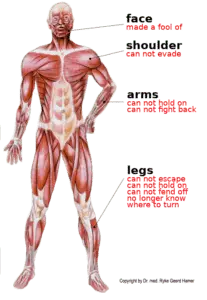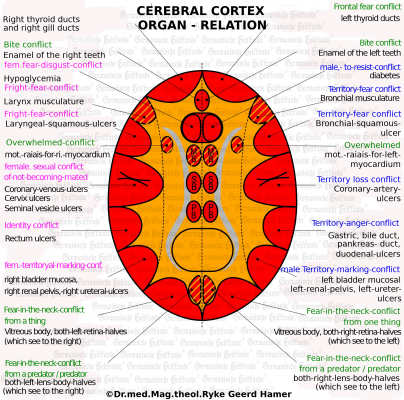But “only” hanging healing, which never comes to an end.
In Germanische Heilkunde®, every so-called disease is a two-phase event – as far as it comes to conflict resolution. Typical for every so-called disease is that it always has a DHS. It has a sympathicotonic phase after the DHS. If there is a conflict resolution (CL), a vagotonic healing phase also follows, accompanied by an epileptic or epileptoid crisis. However, if resolution does not occur, then the conflict activity continues, i.e., the conflict remains monophasic. This can mean that the disease ends in cachexia, or the organism manages to transform the conflict down, i.e., the conflict activity remains but is not so strong.
But a conflict can also be recurrent. Then there are again two possibilities: e.g., there is predominantly conflict activity, detached from small or short healing phases, then we speak of a chronic-recurrent conflict event, or the conflict is quasi permanently in solution, but never comes to an end because there is always a short conflict-active recurrence beforehand.
 This is the case, for example, with the so-called Parkinson’s disease, where the patient usually has his Parkinson’s tremor (trembling), which is a form of healing, more precisely, a healing of a motor conflict, most of the hand muscles. At night, for example, the patient regularly re-dreams his conflict, only briefly, but violently. The healing is 23 hours and maybe 58 minutes, the conflict recurrence is only 2 minutes, and still, this healing does not come to an end. We speak then of hanging healing, which corresponds quasi to a chronic-recurrent conflict, only that the time distribution is another. So, it is permanent healing, only replaced by short conflict recurrences, i.e., the return of the same original conflict.
This is the case, for example, with the so-called Parkinson’s disease, where the patient usually has his Parkinson’s tremor (trembling), which is a form of healing, more precisely, a healing of a motor conflict, most of the hand muscles. At night, for example, the patient regularly re-dreams his conflict, only briefly, but violently. The healing is 23 hours and maybe 58 minutes, the conflict recurrence is only 2 minutes, and still, this healing does not come to an end. We speak then of hanging healing, which corresponds quasi to a chronic-recurrent conflict, only that the time distribution is another. So, it is permanent healing, only replaced by short conflict recurrences, i.e., the return of the same original conflict.
According to the ontogenetic system of tumors and cancer equivalents, all cells or organs developed from the outer germ layer (ectoderm) show cell reduction (necrosis, ulcers) in the conflict-active phase. In the case of the so-called cancer equivalents (everything that is not cancer is cancer equivalent), functional impairment, or loss of function, e.g., paralysis.
In all motor paralyzes, just as in the bone skeleton or sensory paralyzes, it depends on the affected person’s left- and right-handedness. In right-handers, all muscles on the right side have to do with partners, and all muscles on the left side have to do with children or one’s mother. In left-handers, everything is the other way around. In the case of bilateral paralysis, both groups have always been involved in the DHS (at least in thought). Each muscle and muscle group has its conflict meaning. For example, with the extensor side of the leg, the right-handed person pushes the partner away. With the flexor side, he embraces him.
The only exception is when a particular muscle is affected locally, e.g., because someone’s foot gets caught in the car seat belt and hits his head hard. Then, of course, in the case of a right-handed person, for example, if it is the left foot, this has nothing to do with his children or his mother.
There are two types of paralysis: motor, which we can assign to the motor cortex center of the gyrus precentral, and sensory, which we can assign to the sensory cortex center of the gyrus postcentral, where here the pathway of afferent conduction is blocked. The conflict contents are, of course, different.

In motor conflicts, it is always a conflict of not being able to escape or keep up (legs), not being able to hold on or fight off (arms, hands), or not being able to avoid (shoulder, back muscles), no longer knowing out nor in (paralysis of the legs).
In the conflict-active phase, with the onset of DHS, we see an increasing paralysis. They depend on the intensity of the conflict. Fewer and fewer or no impulses for the striated musculature emanate from the cerebrum’s motor cortex center. Individual muscles, whole muscle groups, or even whole limbs may be affected. However, the paralysis is not painful.
In the motor cortex center frontally (right or left, depending on the handedness), so-called shooting target rings (Hamer Focus) are seen in the brain’s computer tomogram.
If the motor conflict is resolved, these target rings in the brain become oedematous. As a result, motor function in this pcl-phase (healing phase) temporarily appears to deteriorate.
Invariably, there is also an epileptic seizure, because invariably each pcl-phase, unless previously interrupted again by a relapse, has an epileptic crisis with tonic, clonic, or tonic-clonic twitching or convulsions at the peak of the healing phase. At the end of the healing phase, the paralyzes gradually recede.
The old idea that brain cells were destroyed during these epileptic seizures was erroneous. The fact is only that the affected Hamer Focus in the brain becomes increasingly scarred, but this is also the case with frequent recurrences of all other Sensible Biological Special Programs (SBS). Each disease has its particular pcl symptoms that start with conflict resolution.
How unconcerned and simple-minded our brain surgeons dealt with this facultative knowledge is shown by the fact that they tried to operate out “epileptic foci” all over the country, which of course, always led to an irreparable paralysis of the affected muscle groups.
However, in Parkinson’s disease, there is never a final cure; we, therefore, speak of a “hanging healing.”
 Example: A right-handed patient dreamed every night of an incident that had occurred in the war year 1944. Partisans had ambushed a troop of German soldiers. Thereupon the soldiers surrounded the village and demanded the population to betray the partisans. As a pressure, they took out the wife and child of a suspected partisan and threatened to shoot them both. When nothing happened, the patient’s best friend was ordered to carry out the execution. When the latter raised the rifle to fire, the patient, as a young soldier, jumped forward, yanked his comrade by the shoulder, and shouted, “You rascal, you can’t do that.” The commanding officer ignored the incident, for prevention was also punishable by death, but the execution took place anyway. The patient dreamt this scene every night anew… and then during the day, he had a Parkinson’s tremor in his right hand and arm, with which he wanted to tear the comrade away by the shoulder. After the patient was able to “work through” this terrible experience, the dreams gradually disappeared, as did Parkinson’s. Today the patient is cured of it.
Example: A right-handed patient dreamed every night of an incident that had occurred in the war year 1944. Partisans had ambushed a troop of German soldiers. Thereupon the soldiers surrounded the village and demanded the population to betray the partisans. As a pressure, they took out the wife and child of a suspected partisan and threatened to shoot them both. When nothing happened, the patient’s best friend was ordered to carry out the execution. When the latter raised the rifle to fire, the patient, as a young soldier, jumped forward, yanked his comrade by the shoulder, and shouted, “You rascal, you can’t do that.” The commanding officer ignored the incident, for prevention was also punishable by death, but the execution took place anyway. The patient dreamt this scene every night anew… and then during the day, he had a Parkinson’s tremor in his right hand and arm, with which he wanted to tear the comrade away by the shoulder. After the patient was able to “work through” this terrible experience, the dreams gradually disappeared, as did Parkinson’s. Today the patient is cured of it.
The great danger is always that the patients suffer a second motor conflict due to the diagnosis shock. This is the case, for example, with the diagnosis of Parkinson’s disease and almost always with the diagnosis of multiple sclerosis; here, for example: “You have MS and will never be able to walk again,” or something like that. Thus, the patient immediately suffers a second conflict, “of never being able to walk again,” which most definitely sticks as a quasi posthypnotic engram due to the patient’s belief in the diagnosis. Which was not true and thus made the patient very difficult to access for therapy. Also, about 70-80% of our so-called “paraplegics” might belong to this category.
In the case of the skin’s cerebral cortex-controlled sensory deafness, except for the sensory nerve plexus lying on the periosteum, the squamous epithelium of which was degenerated in the developmental history, is always accompanied by ulcers of the affected squamous epithelial layer. Here the conflict is the fear of not being able to feel, which is usually fatal in nature; in the further than body contact loss fear, or abandonment (fear) conflict: conflict of being left in the lurch, isolation conflict: conflict of not having more contact with the members of the family, pack, horde, herd, etc.
The healing phase then always shows the urticaria appearing in its various form or the healing of the ulcers or neurodermatitis accompanied by hyperesthesia, swelling, and bleeding. In the epileptoid crisis, however, we see an absence that may even once last for days.
All motor paralyzes, whether we have called them multiple sclerosis, muscular dystrophy, muscular atrophy, ALS = amyotrophic lateral sclerosis or so-called “white or pale” stroke, or also Parkinson’s disease – their origin can be explained according to the Five Biological Laws of Nature of Germanische Heilkunde®. They can also disappear in the same way with understanding these 5 Laws of Nature.
Copyright Dr. Hamer
Translated: John Holledauer
TODAY: 0
LAST 30 DAYS: 3.221
THIS YEAR: 33.168
TOTAL: 152.283
| Cookie | Duration | Description |
|---|---|---|
| cookielawinfo-checkbox-analytics | 11 months | This cookie is set by GDPR Cookie Consent plugin. The cookie is used to store the user consent for the cookies in the category "Analytics". |
| cookielawinfo-checkbox-functional | 11 months | The cookie is set by GDPR cookie consent to record the user consent for the cookies in the category "Functional". |
| cookielawinfo-checkbox-necessary | 11 months | This cookie is set by GDPR Cookie Consent plugin. The cookies is used to store the user consent for the cookies in the category "Necessary". |
| cookielawinfo-checkbox-others | 11 months | This cookie is set by GDPR Cookie Consent plugin. The cookie is used to store the user consent for the cookies in the category "Other. |
| cookielawinfo-checkbox-performance | 11 months | This cookie is set by GDPR Cookie Consent plugin. The cookie is used to store the user consent for the cookies in the category "Performance". |
| viewed_cookie_policy | 11 months | The cookie is set by the GDPR Cookie Consent plugin and is used to store whether or not user has consented to the use of cookies. It does not store any personal data. |
You’ll be informed by email when we post new articles and novelties. In every email there is a link to modify or cancel your subscription.